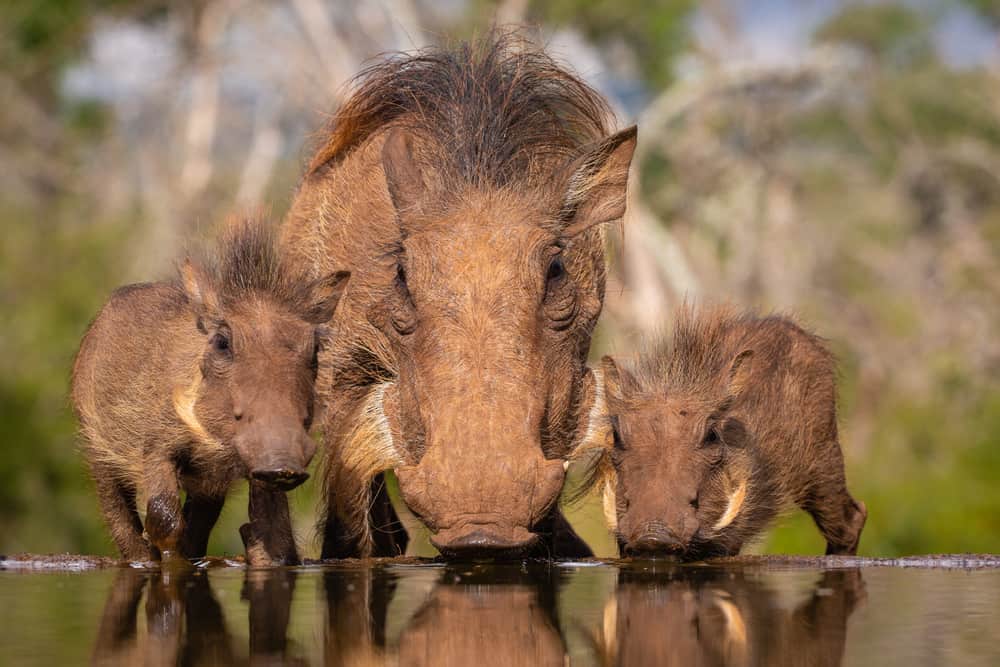Many of us will have first encountered a warthog when we sat down to watch Disney’s The Lion King back in the 1990s. Pumba, with his meerkat friend Simone, was a big, chunky, loveable rascal with a love for ‘slimy yet satisfying’ bugs and a fiercely loyal temperament. But exactly just how accurate a depiction of the real-life warthog was Pumba?
Warthogs belong to the pig family of Suidae, sharing many similar characteristics with pigs, hogs, and swine found all around the world. The main difference being: warthogs haven’t been domesticated, and instead roam the African continent freely, raising their families and foraging for food.
There are two different species of warthog: the common warthog (Phacochoerus africanus) and the desert warthog (Phacochoerus aethiopicus) – both of which reside exclusively in Africa, and which are, by and large, the same beast. There are some minute differences between the two, however, and so in this animal guide to warthogs we’ll be sure to make the distinction clear!
We’re going to walk you through the habits, habitat and other behaviors of the common and desert warthog, before then examining what each eats, how they find their food, and what other animals hunt them. We’ll round out this article with some pretty cool facts about these awesome, underrated African animals.
Habits, Habitat & Behavior
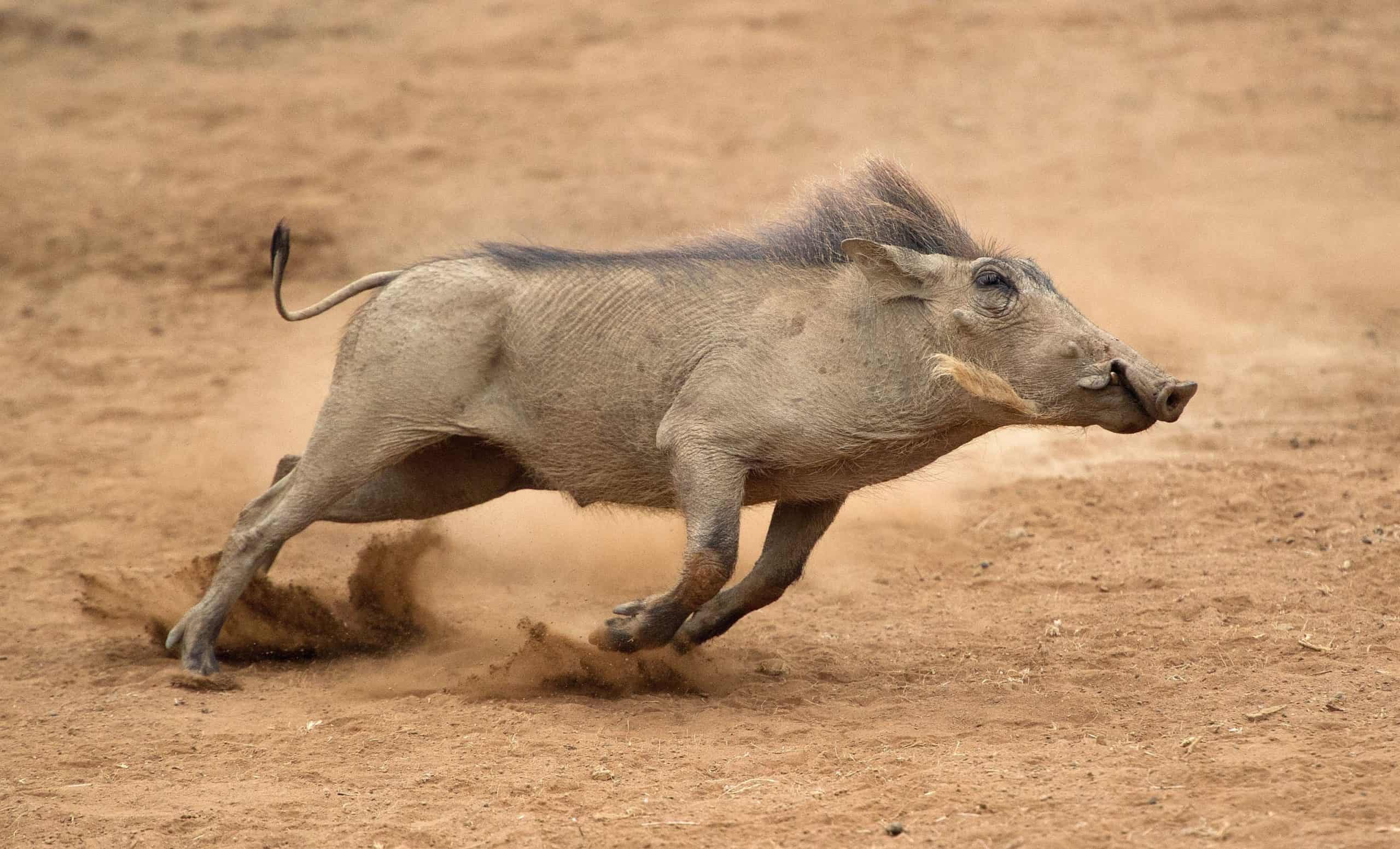
Shared Characteristics
Warthogs (both desert and common) are not necessarily the prettiest of animals. They have long-yet-squat bodies covered in a fine, bristly hair, propped up on four legs which are taller than any other legs of animals found in the Suidae family. These long legs allow warthogs to run at startling speeds of up to 34MPH (55KM/H).
Their heads are shaped a little like hammers: strong, flat, large and long and are covered with the calloused fleshy lumps (or ‘warts’) for which they were named. Warthogs have two pairs of tusks protruding from their snouts. The upper pair is large and curves upward to form a crescent moon, whilst the lower pair has a sharp, cutting edge.
The warty pads on the sides of their faces are largely used by males during the mating season, to cushion the impact when butting heads with other males in competition for the privilege to mate with a nearby female.
Warthogs have a very distinct ‘mane’ of hair starting at the crest of their skull and growing down their spine until midway along their backs. They are generally reddish-brown to gray in color.
Male warthogs prefer to live alone, wandering their territories in search of food, whilst females may roam in communities of up to 40 other female warthogs and baby warthogs (called ‘piglets’). Warthog litters generally include up to 4 young, because female warthogs only have 4 teats. Interestingly, a female warthog will chase away the previous litter she has been raising in order to safely give birth to the next.
They are supremely adept at surviving in the harsh climes of Africa, and can go without water sometimes for several months, like during the dry season, taking what moisture they can from their diet.
However, when warthogs do find water (or even mud, for that matter) they like to lie down and wallow in it. This helps them to keep cool, but also helps to protect them from the ravaging bites of flies and insects.
Both varieties of warthog prefer wide open spaces to woodlands or rocky, mountainous locations. When seeking sleep or protection, warthogs burrow into the earth, or steal the dens of other animals, such as those of aardvarks.
Common Warthog
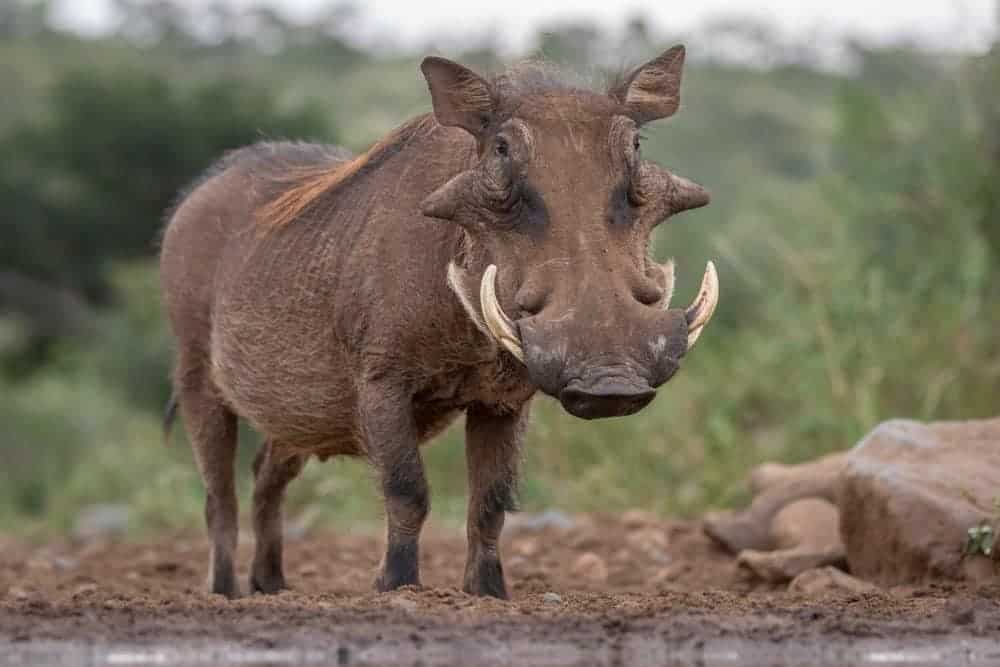
Whilst all warthogs share the above characteristics, the common warthog has adapted to live on exclusively on the African savanna: a term which refers to large, open, generally flat swathes of grassland. Savanna is mostly found in sub-Saharan Africa, and as such common warthogs can be found in most parts of the African continent.
As we’ll discover in the next section, common warthogs have adapted their diet to include foods available on the savanna which their cousins, the desert warthogs, do not have access to. The common warthog is the most numerous warthog, and its conservation status is listed as ‘Least Concern’, indicating that it is a healthy and plentiful species whose numbers are not currently in immediate danger.
Having said this, human urbanization, climate change, and hunting, are all contributing to the dwindling numbers of most species of animal, and as such, in time even the resilient and resourceful common warthog will not be safe, unless we change our ways.
In particular, common warthogs are hunted wherever their presence is linked to the disappearance of human crops.
Desert Warthog
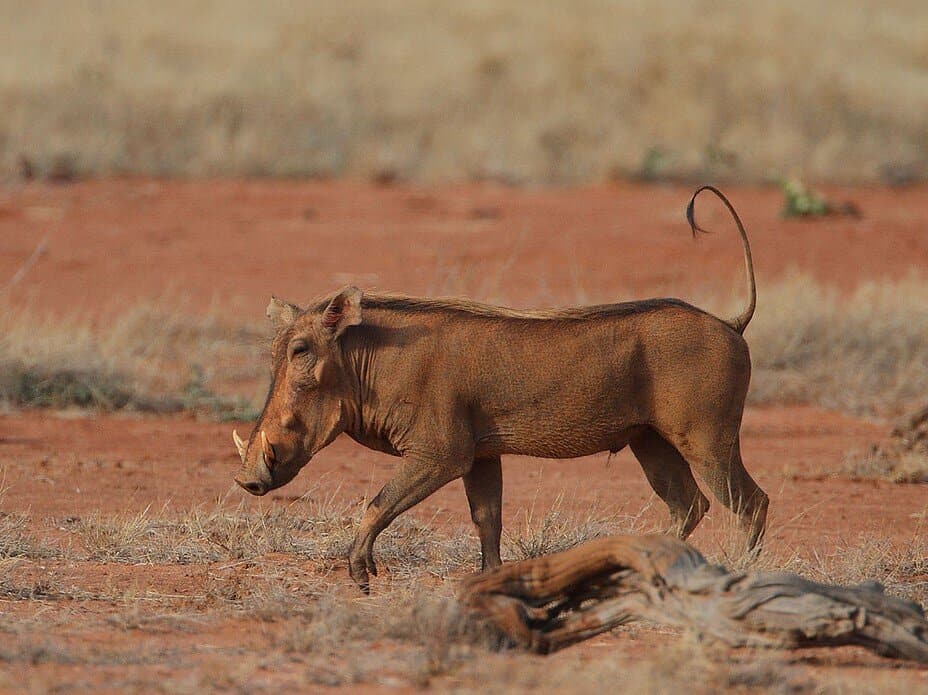
In contrast, the desert warthog is much rarer, and is found only on the Horn of Africa, in countries like Somalia, Kenya, and Ethiopia. The habitat of the desert warthog is, you guessed it, mostly dry, arid, desert areas, where their food sources are limited. As such, desert warthogs often have to be even more resourceful than their common cousins.
Desert warthogs are generally a little smaller in size than the common warthog, but that doesn’t stop them reaching weights of around 120-250lbs! Female desert warthogs, like common ones, move in groups called ‘sounders’ whilst the males tend to work alone.
What Do Warthogs Eat?
Put it this way, warthogs aren’t fussy. Like most animals in the pig family, they are omnivores, eating both plants and animal matter. However, unlike other omnivores, their diet is almost exclusively that of herbivores. Whilst they may consume insects, eggs, and (very occasionally) the leftovers of predators, they generally stick to grass, roots, barks and bulbs.
Common warthogs have the most varied diet, and like to feast on all of the different grasses found on the savanna grasslands. In fact, they eat around 34 different species of grass, which are found most abundantly during the wet seasons. In addition, they’ll munch on the roots and bulbs of plants hidden below the dirt, and – when food is scarce – won’t think twice about guzzling down berries, fruits, old bones and bark.
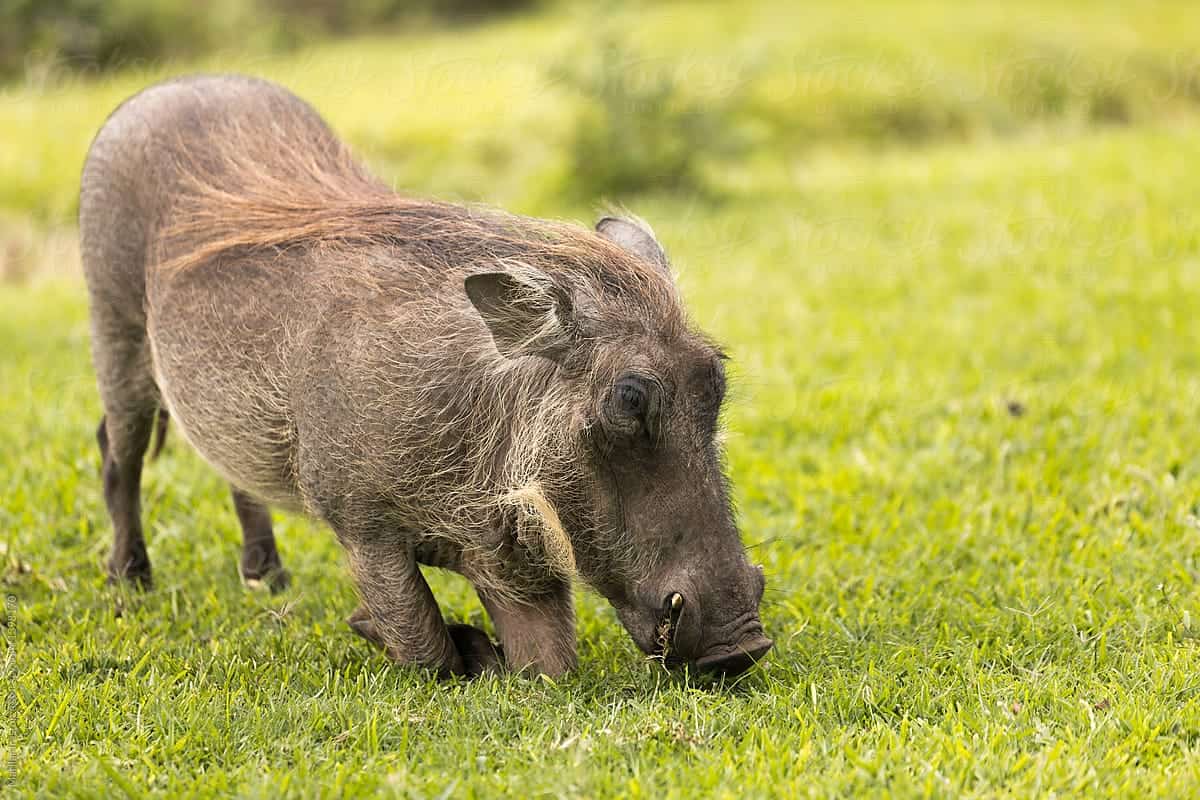
Desert warthogs don’t have the luxury of choice that common warthogs do. They’re limited instead to what few grasses, roots, rhizomes, and bulbs they can find in the desert. Because their lives are that bit tougher, they have been reported to even eat the dung of other animals (and their own).
Very rarely (and we mean, very rarely) warthogs of both species have been found eating carrion carcass (specifically the stomach and intestinal contents of dead animals at predator kill sights).
Here’s a list of all the foods warthogs have been known to eat:
- Grasses
- Tubers
- Bulbs
- Rhizomes
- Roots
- Barks
- Insects
- Fruits
- Leaves
- Berries
- Carrion (very rarely)
- Dung
How Do Warthogs Get Their Food?
Warthogs have tremendously large nostrils which are mostly used in the search for food. Since warthogs are largely grazers, they get most of their food by moving with their noses and mouths close to the ground, grazing and munching on the grasses peaking up above the soil.
When food is scarcer, warthogs have to dig, or “root”, for their food. They move around on the knees of their forelegs to get as close to the ground as they can, and then use their extremely keen sense of smell to detect where roots, bulbs, tubers and rhizomes are located. Once they’ve found the spot, they use their snouts and hooves to dig down into the dirt to find their next meal. Interestingly, they never use their tusks for this job!
For water, warthogs are forced to rely mostly on the rich moisture content of the bulbs and tubers they eat. However, they will also drink from puddles, lakes, and rivers, when the chance arises. As you’ll find out in the next section, however, this can be a dangerous game!
What Animals Eat Warthogs?
On the continent of Africa, it seems almost every second wild animal is a “super predator”. Lions, tigers, cheetahs, crocodiles, leopards, hyenas (in packs) you name it, they eat warthogs. Even eagles will sometimes feast upon a piglet now and again.
Thus, though warthogs can run crazily fast, and often put up a mean fight in defense of themselves and their young, they are often at the mercy of Africa’s extremely deadly wildlife.
Lions are the top predators of warthogs, especially dangerous to the pigs because they are able to dig warthogs out of their dens and thus kill them. Additionally, crocodiles are common predators of warthogs, lying in wait by the water’s edge for a thirsty warthog to snatch!
5 Unique and Interesting Facts About Warthogs
Warthogs start the day running!
Whilst you or I might be able to fall lazily out of bed and trudge to the breakfast table, warthogs are afforded no such luxury. Instead, they have to leave their dens at a flat-out run, just in case a sneaky predator is lying in wait to grab them.
Warthogs use their tusks like castle walls
Baby warthogs (piglets) dive head-first into dens and burrows when under threat, but adults are smarter. Adult members of the pig family on the African continent reverse themselves into their dens, so that only their mean, ferocious-looking tusks are left poking out. They use these tusks like castle walls, to make their dens as unimpregnable as possible.
Warthogs know how to avoid human hunters
Warthogs prefer to search for their food during the twilight hours (dusk and dawn) and at night. However, in areas where they are hunted by humans, they have been known to hunt only at night, so as to be active only during the hours when humans are asleep.
Warthog scent glands aren’t found where you’d expect them to be
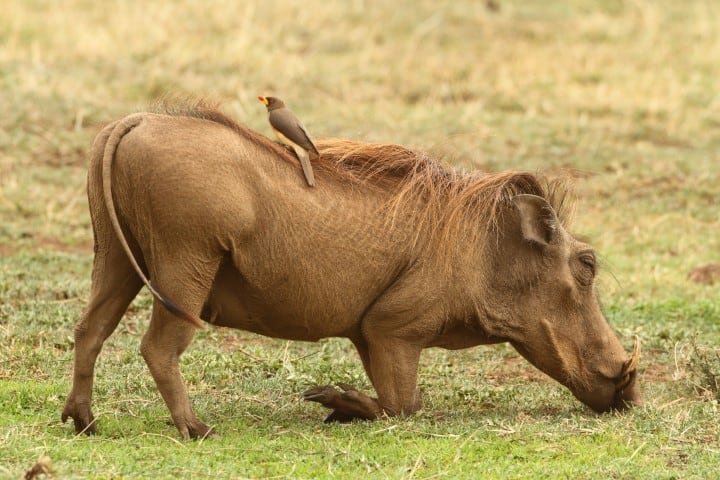
Instead of in the anus, warthog scent glands are found under the lips and in the eyes, believe it or not. They rub their heads, lips and eyes against tree trunks to leave their scent behind and thus mark their territory.
Warthogs and mongooses have a very special relationship
We’ve known for a while that warthogs (and other large mammals like hippos and elephants) will often rely on birds to help them get rid of tics, fleas, and other flies and insects which bite and cause them irritation. But did you know that some warthogs have even developed this special relationship with mongooses?
Conclusion
Warthogs might not seem very interesting or attractive from the outside, but like every member of the animal kingdom, they have their fair share of secrets. Resourceful, skillful, and able to adapt to changing circumstances at the drop of a hat, they have managed to survive extremely well, even on a continent as full of predators, and as often harsh, as Africa.
